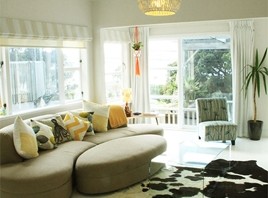
Decorating your home is as simple as choosing a paint colour for the walls, plonking some furniture down and making sure there's enough light in the space, right?
Not quite – while decorating your living space doesn't need to be a complicated affair, some thought about specific placement of your furniture can go a long way.
No matter what aesthetic you go for, considering the mathematics behind your living room can be a very beneficial exercise.
Why a numbers game?
To very, very loosely paraphrase George Orwell, all living rooms are equal, but some are more equal than others.
Some living spaces are particularly expansive, while others are pressed for space (though they're homely nevertheless). It's not just size that changes between properties – living room shapes can differ massively.
Some areas will be conventional and rectangular, while others will have unique angles, nooks and the like. However, rather than seeing unique room shapes as a hindrance, instead look to embrace interesting angles and alcoves.
Before taking inspiration from home decorating ideas and completing shaking up your living room, grab a tape measure and get an idea of what kind of dimensions you're working with.
There's no point investing in a lavish new sofa if its size is going to dwarf a room. Likewise, adding too many pieces of small furniture to a large, open-plan space could look equally odd.
Don't just think about the width and length of the home – be sure to consider a room's height, too. The more vertical space you have to grapple with, the greater the opportunities from smart overhead storage solutions. However, you'll also need to pick drapes and paint colours carefully, depending on your living room's ceiling height.
When you've got these measurements under your belt, you'll find investing in furniture, rugs and artwork is much easier.
Define your space
Once you've established your living room's dimensions, you can move onto the colour palette and furniture arrangement. If you want to create the impression of space, opt for shades like Resene Thorndon Cream or Resene Merino for the walls.
If you've got a particularly low stud, consider embracing two similar neutral hues, with the deeper shade taking up the lower two-thirds of the wall and the lighter shade taking up the upper third. This will give the impression of a more elongated space.
Floor-to-ceiling drapes will also elongate a space, while blinds confined to the perimeter of your windows are a smart move for oversized living zones.
In smaller areas, opt for a single sofa, which can help create a focal point in the room without overwhelming the area.
If you want to create separate zones within a large, open-plan space, consider investing in a sectional sofa. The L-shape will completely redefine an area, so you can have an entertainment space with a television and sound system in one corner of the room and a dining area in another.
In terms of pieces such as coffee tables, make sure their size is in proportion to couches and chairs in terms of diameter. If you've got a small living room, whether due to a small stud or limited floor space, consider opting for a low coffee table in order to balance out the feel of the room.
You can also use rugs to give the impression of a more spacious room or to create pockets of interest. For instance, a long rug can create a sense of intimacy, particularly if you place the front legs of couches and chairs on it, as well as a coffee table in the centre.
Several smaller rugs are a good option if you want to create individual areas within a larger space, but make sure their total surface area doesn't take up more the one-third to half of the room's total floor space.


